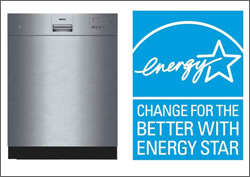DOE Announces Nearly $300 Million for Energy Efficient Appliances
July 14, 2009

U.S. Department of Energy (DOE) Secretary Steven Chu today announced the availability of nearly $300 million in funding from the American Recovery and Reinvestment Act for state-run rebate programs for consumer purchases of new ENERGY STAR® qualified home appliances. The new program underscores the Obama Administration's commitment to make American homes more energy efficient, while helping to support the nation's economic recovery.
"Appliances consume a huge amount of our electricity, so there's enormous potential to both save energy and save families money every month," said Secretary Chu. "These rebates will help families make the transition to more efficient appliances, making purchases that will directly stimulate the economy and create jobs."
The new funding will be awarded to states and territories, through their energy offices, using a formula set forth in the Energy Policy Act of 2005. Each state or territory is required to submit a plan that specifies which ENERGY STAR appliance categories will be included in their rebate program, the rebate level for each product type, how the rebates will be processed, and their plan for recycling old appliances. States and territories must first file an initial application expressing their intent to participate by August 15, 2009, followed by a full application by October 15, 2009. Approximately 10-25% of each award will be spent on administrative costs.
States and territories will receive 10% of the funds after submitting the initial application with the balance awarded after their program plans are approved. DOE anticipates that a vast majority of funding will be awarded by November 30, 2009. The complete Funding Opportunity Announcement, under number DE-FOA-0000119, can be viewed at Grants.gov. See the funding allocations for each state and territory (PDF 11 KB). Download Adobe Reader.
Eligible Appliances
States have the flexibility to select which residential ENERGY STAR qualified appliances to include in their programs and the individual rebate amount for each appliance. DOE recommends that states and territories focus their program efforts on heating and cooling equipment, appliances, and water heaters as these products offer the greatest energy savings potential. ENERGY STAR qualified appliance categories eligible for rebates include: central air conditioners, heat pumps (air source and geothermal), boilers, furnaces (oil and gas), room air conditioners, clothes washers, dishwashers, freezers, refrigerators, and water heaters.
The Recovery Act appropriated funds for the program to help achieve the national goals of spurring economic growth, creating jobs, saving energy, and reducing greenhouse gas emissions. States and territories can use these funds to leverage the utility companies and energy efficiency program sponsors in their area.
This program will also leverage the power of the ENERGY STAR program, a well-known labeling program that helps consumers make energy smart choices by identifying the most energy efficient products. ENERGY STAR is a joint program of the U.S. Environmental Protection Agency and the U.S. Department of Energy that covers more than 60 product categories and is supported by a network of almost 600 utility and state and government partners serving more than 74 million households, over 2,000 retail partners representing more than 27,000 storefronts, and 2,645 manufacturers of ENERGY STAR qualified products.
For more information on these and other Recovery Act related funding opportunities, visit the U.S. Department of Energy's Recovery and Reinvestment Web site.



